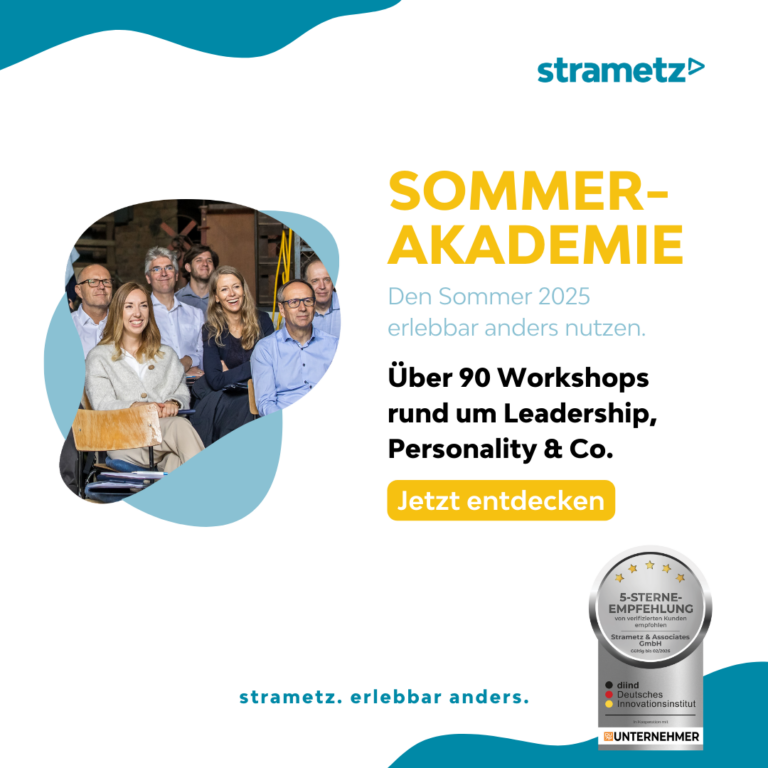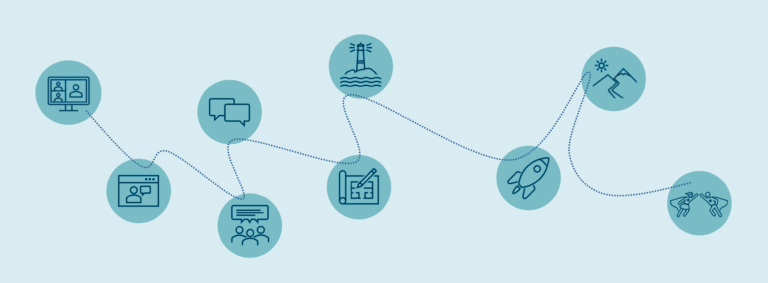Aspects of change – What is there to change?
People are complex. “He sure has changed a lot lately,” we sometimes hear someone say about a fellow human being.
In job advertisements, we read that flexibility and thus willingness to adapt is expected. Managers want and demand to work on weaknesses, because each individual is supposed to become better – or at least different.
But can we change at all? What is it exactly that can and can be changed about us? And? Can this be done arbitrarily? How much is there to the fact that someone has “revolutionized,” that is, visibly changed?
These questions can be considered from at least two aspects, which we will explore in the following article: One is personality – the other is behavior. When we speak of personality, we mean the inherited and through the environment acquired imprint and basic structure. Behavior includes all of a person’s actions and reactions that can be observed and/or measured.
Personality change versus behavior change
According to neurobiologist Gerhard Roth, the epigenetic mechanism, early childhood and the period up to the age of 14 are crucial for personality development. After puberty, around the age of 21, the personality consolidates, which then also decreases its plasticity. This means that personality change is rather difficult afterwards. However, this is [nbsp]quite different from person to person. Some are relatively plastic and three-dimensional while others solidify early.
Specht and Gerstorf also confirm that no significant changes in personality occur in healthy individuals after the age of 30; only changes in habits and attitudes are suspected .
In middle adulthood, stability and stagnation of intrinsic maturation can be expected.
Specht and Gerstorf found that this depends primarily on the adoption of new, social roles. People who make a change of scenery by going abroad, for example, experience a leap in their character development. The fewer new, social roles we take on in middle adulthood, the more our personality development stagnates.
Thus, changes in social roles or the adoption of new roles seem to have a high impact on long-term personality development.
However, since this decreases significantly in middle adulthood, it can be stated in a first interim conclusion that personality change is not possible at will after a certain age.
Nevertheless, change is a keyword and an attitude expectation for everyone these days – especially when you think about the prevailing VUCA world. The continuing education industry floods its programs with seminars and courses that train social skills to help people improve and behave more appropriately and successfully. From this it can be deduced that change must somehow be possible throughout after all. That’s why research starts at this point of behavior change. In practice, this means that there are methods for developing one’s potential as fully as possible.
For behavior change to be possible, change resources are required, which in turn are anchored in the personality:
1.will to change
2. inner peace and serenity
3. empathy
You “only” have to want to change, believe that change is possible – in other words, believe – and do it, confirms psychologist Marie Hennecke from the University of Siegen. Mere intention without action would most likely not help. It would depend on practicing new behavior patterns.
A 2018 study by Jonathan Allan and his colleagues shows that motivated people change in the desired direction within a short period of time as a result of a coaching program. However, this does not work indefinitely, Professor Wrzus found out, because everyone should also retain their character traits to a certain extent.
The bottom line:
Personality traits can change over the long term if there is the will and motivation to adapt when faced with new challenges. Faster success can be achieved with behavioral adjustment – but this must fit the basic personality structures.
What about the will to learn and change?
To get the will going, people need a motive. According to neurobiologist Gerhard Roth, will only arises when the brain can count on the satisfaction of personal motives.
A study by kursfinder.de in cooperation with the HRM Research Institute in Germany 2019 shows that in companies with increasing training budgets, the majority of employees stay 10 to 15 years. If companies lack development opportunities, it can lead to frustration in the long run – and as a result, motivation drops. If there are sufficient development opportunities, this is a central reason to become involved in the company. The important thing here is that the development options must accommodate personal motives.
According to the study, people have a need for lifelong learning – that is, they want to get to the bottom of things, they want to stay up-to-date, they want to develop further and thus – in the broadest sense – adapt their behavior, always provided they see an opportunity for further development that corresponds to their motives.
In view of the changes taking place in the economy, many managers are looking at their staff with concern: Will the employees be ready and willing to go along with the changes and, above all, to support them? Yes, they are, confirms a team from Harvard Business School and the BCG Henderson Institute. All that is needed is to create the right conditions for it.
U.S. author Marianne Williamson underscores this point: “We all already have our potential for change within us.”
The will is there – How can companies use and promote the willingness to change?
The topics of “individuality”, “development prospects” and “talent management” are becoming increasingly important in HR development work.
Because the less learning input and individual development opportunities or new social roles are made possible for employees, the faster a “feeling of thirst” can set in and with it fluctuation and the search for new experiences, new knowledge, one’s own further development.
Companies should derive an important competitive advantage from their employees’ willingness to develop further. They should start looking at their employees as talent and energy reserves that they can tap into with smart training and individual career development opportunities. Employees are willing and able to change to a much greater degree than managers think. This is also evidenced by the study mentioned above.
Moreover, talented people see themselves as primarily responsible for their (own) development anyway – so why not give them the sovereignty? It can be assumed that they are then also more motivated to perform, according to Faßbender and Richter.
Quite practical:
Activation and experience
Behavior change is especially favored when emotional activation and a positive corrective experience come together.
If, for example, someone is afraid to express criticism or to address a conflict, then it is of little use to merely talk about it and give this person recommendations for action. Only in a well-planned exercise or simulation can this fear be activated and experienced through an appropriate reaction to it, e.g. in such a way that the expression is responded to constructively and the person experiences that it does not have a negative impact on the relationship or does not cause rejection. Then, with further training in appropriate conversational techniques, one can increase confidence in the new behavior, reinforcing the transformative experience.”
Find out the motives of your employees
What is the intrinsic motivation of the employee? What does he need to achieve stable life satisfaction? What drives him?
Offer “playing fields” for new experiences
If you seek out situations where you feel comfortable, development doesn’t happen – it takes new terrain with new experiences to develop, according to Prof. Wrzus. Keyword: leaving the comfort zone.
Channel the ambition of your employees
Harness the ambition of your employees, create a culture of learning, involve your employees in the transformation. Because learning by doing on scenarios that are as real as possible has a strong effect on the sustainability of what is learned and on its implementation.
Invest in social skills training
Trainings should not be underestimated. Social skills training, for example, has the best effects on personality development, summarizes Prof. Wrzus.
Set up a “green meadow
Give employees the opportunity for Natural Learning. Learning expert Jay Cross uses this term to describe a mix of play, trial and error, discovery, driven by an inherent curiosity and having fun.
Because what you have learned with joy and pleasure, you also like to use and implement afterwards. The opposite of this would be to take the fun and pleasure out of learning. But that certainly doesn’t apply to your company.
Behavior change with Strametz [&] Associates
From our innovative Personal Profiling Tool-Set to modern Leadership-oriented Assessment and Development Centers to individually designed People Management with behavior-oriented simulations and Active Learning offerings, we have been one of the leading providers of innovative solutions for personnel and organizational development for over 40 years.
We would be happy to develop the right concept for you or your managers and employees.
For further interesting insights please have a look at our news section
Sources:
Bauer, L.: Can we change? Brain and Mind, 01/2020, page 12 ff.
Bußmann N. with Roth G.; Wie veränderbar ist der Mensch, Managerseminare 02/2019; page 56 ff.
Faßbender, N. with Richter, N. (2020): With tailwind to the ascent. Human Resources 04/2020, p. 24ff.
Prof. Fuller, J.; Wallenstein, J.; Raman, M.; De Chalenda A.: Employees want to learn; Managers Seminars Special In-service Learning, 05/2020, page 4 ff.
Prof. Wrzus, C.: It would be bad if we were all the same; Gehirn und Geist, 01/2020, page 19 ff.
Steffen, A: People and organizations in transition; Springerverlag 2019; page 308
Specht, J.; Gerstorf, D.: Personality development and coaching; In. Greif S. et al Handbook of key concepts in coaching. Springer 2018; pp. 441 ff.










